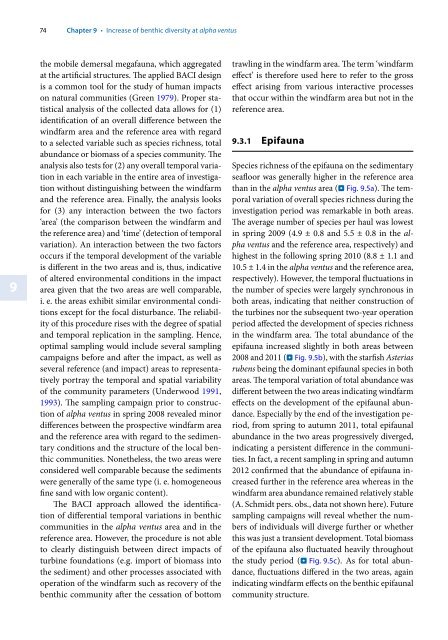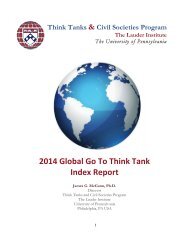bok%3A978-3-658-02462-8.pdf?auth66=1398409209_a0514c2b8e531c058ab8b810a0cad74d&ext=
bok%3A978-3-658-02462-8.pdf?auth66=1398409209_a0514c2b8e531c058ab8b810a0cad74d&ext=
bok%3A978-3-658-02462-8.pdf?auth66=1398409209_a0514c2b8e531c058ab8b810a0cad74d&ext=
- No tags were found...
You also want an ePaper? Increase the reach of your titles
YUMPU automatically turns print PDFs into web optimized ePapers that Google loves.
74Chapter 9 • Increase of benthic diversity at alpha ventus1234567891011121314151617181920the mobile demersal megafauna, which aggregatedat the artificial structures. The applied BACI designis a common tool for the study of human impactson natural communities (Green 1979). Proper statisticalanalysis of the collected data allows for (1)identification of an overall difference between thewindfarm area and the reference area with regardto a selected variable such as species richness, totalabundance or biomass of a species community. Theanalysis also tests for (2) any overall temporal variationin each variable in the entire area of investigationwithout distinguishing between the windfarmand the reference area. Finally, the analysis looksfor (3) any interaction between the two factors‘area’ (the comparison between the windfarm andthe reference area) and ‘time’ (detection of temporalvariation). An interaction between the two factorsoccurs if the temporal development of the variableis different in the two areas and is, thus, indicativeof altered environmental conditions in the impactarea given that the two areas are well comparable,i. e. the areas exhibit similar environmental conditionsexcept for the focal disturbance. The reliabilityof this procedure rises with the degree of spatialand temporal replication in the sampling. Hence,optimal sampling would include several samplingcampaigns before and after the impact, as well asseveral reference (and impact) areas to representativelyportray the temporal and spatial variabilityof the community parameters (Underwood 1991,1993). The sampling campaign prior to constructionof alpha ventus in spring 2008 revealed minordifferences between the prospective windfarm areaand the reference area with regard to the sedimentaryconditions and the structure of the local benthiccommunities. Nonetheless, the two areas wereconsidered well comparable because the sedimentswere generally of the same type (i. e. homogeneousfine sand with low organic content).The BACI approach allowed the identificationof differential temporal variations in benthiccommunities in the alpha ventus area and in thereference area. However, the procedure is not ableto clearly distinguish between direct impacts ofturbine foundations (e.g. import of biomass intothe sediment) and other processes associated withoperation of the windfarm such as recovery of thebenthic community after the cessation of bottomtrawling in the windfarm area. The term ‘windfarmeffect’ is therefore used here to refer to the grosseffect arising from various interactive processesthat occur within the windfarm area but not in thereference area.9.3.1 EpifaunaSpecies richness of the epifauna on the sedimentaryseafloor was generally higher in the reference areathan in the alpha ventus area (. Fig. 9.5a). The temporalvariation of overall species richness during theinvestigation period was remarkable in both areas.The average number of species per haul was lowestin spring 2009 (4.9 ± 0.8 and 5.5 ± 0.8 in the alphaventus and the reference area, respectively) andhighest in the following spring 2010 (8.8 ± 1.1 and10.5 ± 1.4 in the alpha ventus and the reference area,respectively). However, the temporal fluctuations inthe number of species were largely synchronous inboth areas, indicating that neither construction ofthe turbines nor the subsequent two-year operationperiod affected the development of species richnessin the windfarm area. The total abundance of theepifauna increased slightly in both areas between2008 and 2011 (. Fig. 9.5b), with the starfish Asteriasrubens being the dominant epifaunal species in bothareas. The temporal variation of total abundance wasdifferent between the two areas indicating windfarmeffects on the development of the epifaunal abundance.Especially by the end of the investigation period,from spring to autumn 2011, total epifaunalabundance in the two areas progressively diverged,indicating a persistent difference in the communities.In fact, a recent sampling in spring and autumn2012 confirmed that the abundance of epifauna increasedfurther in the reference area whereas in thewindfarm area abundance remained relatively stable(A. Schmidt pers. obs., data not shown here). Futuresampling campaigns will reveal whether the numbersof individuals will diverge further or whetherthis was just a transient development. Total biomassof the epifauna also fluctuated heavily throughoutthe study period (. Fig. 9.5c). As for total abundance,fluctuations differed in the two areas, againindicating windfarm effects on the benthic epifaunalcommunity structure.




